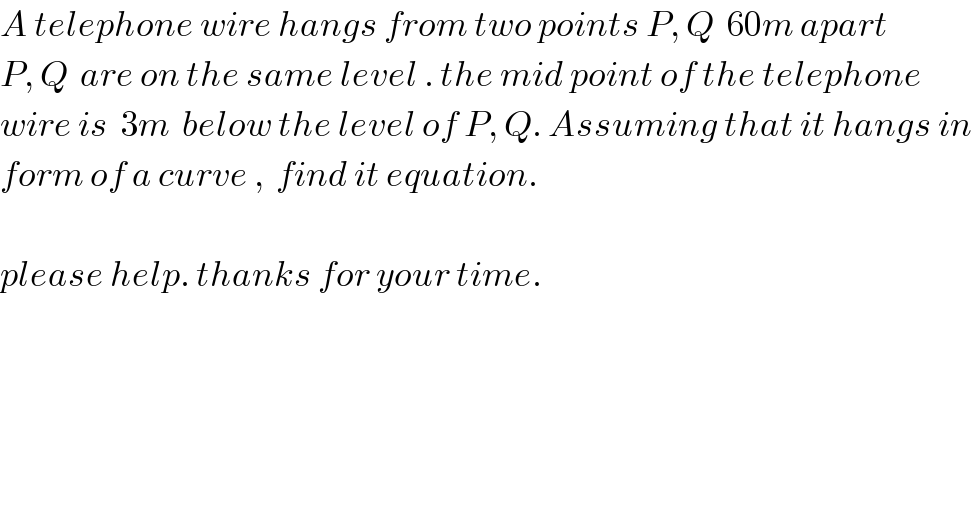
Question Number 6169 by sanusihammed last updated on 17/Jun/16

$${A}\:{telephone}\:{wire}\:{hangs}\:{from}\:{two}\:{points}\:{P},\:{Q}\:\:\mathrm{60}{m}\:{apart} \\ $$$${P},\:{Q}\:\:{are}\:{on}\:{the}\:{same}\:{level}\:.\:{the}\:{mid}\:{point}\:{of}\:{the}\:{telephone} \\ $$$${wire}\:{is}\:\:\mathrm{3}{m}\:\:{below}\:{the}\:{level}\:{of}\:{P},\:{Q}.\:{Assuming}\:{that}\:{it}\:{hangs}\:{in}\: \\ $$$${form}\:{of}\:{a}\:{curve}\:,\:\:{find}\:{it}\:{equation}. \\ $$$$ \\ $$$${please}\:{help}.\:{thanks}\:{for}\:{your}\:{time}. \\ $$
Answered by Yozzii last updated on 17/Jun/16
![Let curve be quadratic where 0≤x≤60 f(x)=ax^2 +bx , a>0, P(0,0), Q(60,0) (P & Q lie on x−axis) ⇒f(60)=0 or 3600a+60b=0 b=−60a........(i) At x=0.5∣PQ∣=30, f′(30)=0 if we assume a uniform wire lies between P & Q. ∴ 2a(30)+b=0 ⇒b=−60a (no new information based on quadratic assumption.) ∴ At x=30,f(30)=−3. ∴900a+30b=−3 300a+10b=−1..........(ii) From (i), in (ii) 300a+10(−60a)=−1 −300a=−1⇒a=(1/(300))⇒b=((−60)/(300))=((−1)/5). ∴ f(x)=(1/(300))x^2 −(1/5)x (0≤x≤60) −−−−−−−−−−−−−−−−−−−−−−−− In general, in x−y Cartesian co−ordinates, we can let P(a,b) and Q(a+60,b) where a,b∈R. This means that one can choose any arbitrary place in the x−y plane to put this curve for x∈[a,a+60]. Assuming the wire is uniform, the example above indicates that the quadratic curve is a suitable model. Let f(x)=cx^2 +dx (c>0). At x=a, f(x)=b ∴ b=ca^2 +da or d=((b−ca^2 )/a) (a≠0).......(i) At x=a+60, f(a+60)=b ∴ c(a+60)^2 +d(a+60)=b ca^2 +c(120a+3600)+da+60d=b 120c(a+30)+60d=0 2c(a+30)+d=0 2ca+60c+(b/a)−ca=0 (from (i)) ca+60c=((−b)/a) c=((−b)/(a(a+60))) ⇒d=(b/a)−a×((−b)/(a(a+60))) d=(b/a)(1+(a/(a+60)))=((b(a+60+a))/(a(a+60))) d=((2b(a+30))/(a(a+60))) Since c>0⇒ −60<a<0 & b>0 or b<0 & a>0 or b<0 & a<−60. ∴ f(x)=((bx)/(a(a+60)))(−x+2a+60) At x=a+30, f(a+30)=((b(a+30)(−a−30+2a+60))/(a(a+60))) f(a+30)=((b(a+30)^2 )/(a(a+60))) f(a+30)−b=((900b)/(a(a+60))) But f(a+30)−f(a)=−3. ⇒300b=−a(a+60) b=((−a(a+60))/(300)). ∴ f(x)=((−a(a+60))/(300))×(x/(a(a+60)))(−x+2a+60) f(x)=((x(x−2a−60))/(300))=(1/(300))x^2 −((x(a+30))/(150)) f(a)=((a(a−2a−60))/(300))=((−a(a+60))/(300)) f(a+60)=(((a+60)(−a))/(300))=b f′(x)=((x−a−30)/(150))⇒at midpoint, f′(x)=0 or x=a+30. We may choose to shift this curve by an amount h vertically so that in general f(x)=(1/(300))x^2 −((x(a+30))/(150))+h (a≤x≤a+60, a,h∈R). a=0 and h=0⇒f(x)=(1/(300))x^2 −(1/5)x as was found.](Q6171.png)
$${Let}\:{curve}\:{be}\:{quadratic}\:{where}\:\mathrm{0}\leqslant{x}\leqslant\mathrm{60} \\ $$$${f}\left({x}\right)={ax}^{\mathrm{2}} +{bx}\:,\:{a}>\mathrm{0},\:{P}\left(\mathrm{0},\mathrm{0}\right),\:{Q}\left(\mathrm{60},\mathrm{0}\right)\:\left({P}\:\&\:{Q}\:{lie}\:{on}\:{x}−{axis}\right) \\ $$$$\Rightarrow{f}\left(\mathrm{60}\right)=\mathrm{0}\:{or}\:\mathrm{3600}{a}+\mathrm{60}{b}=\mathrm{0} \\ $$$${b}=−\mathrm{60}{a}........\left({i}\right) \\ $$$${At}\:{x}=\mathrm{0}.\mathrm{5}\mid{PQ}\mid=\mathrm{30},\:{f}'\left(\mathrm{30}\right)=\mathrm{0}\:{if} \\ $$$${we}\:{assume}\:{a}\:{uniform}\:{wire}\:{lies}\:{between} \\ $$$${P}\:\&\:{Q}. \\ $$$$\therefore\:\mathrm{2}{a}\left(\mathrm{30}\right)+{b}=\mathrm{0}\:\Rightarrow{b}=−\mathrm{60}{a}\:\left({no}\:{new}\:{information}\:{based}\:{on}\:{quadratic}\:{assumption}.\right) \\ $$$$\therefore\:{At}\:{x}=\mathrm{30},{f}\left(\mathrm{30}\right)=−\mathrm{3}. \\ $$$$\therefore\mathrm{900}{a}+\mathrm{30}{b}=−\mathrm{3} \\ $$$$\mathrm{300}{a}+\mathrm{10}{b}=−\mathrm{1}..........\left({ii}\right) \\ $$$${From}\:\left({i}\right),\:{in}\:\left({ii}\right)\:\mathrm{300}{a}+\mathrm{10}\left(−\mathrm{60}{a}\right)=−\mathrm{1} \\ $$$$−\mathrm{300}{a}=−\mathrm{1}\Rightarrow{a}=\frac{\mathrm{1}}{\mathrm{300}}\Rightarrow{b}=\frac{−\mathrm{60}}{\mathrm{300}}=\frac{−\mathrm{1}}{\mathrm{5}}. \\ $$$$\therefore\:{f}\left({x}\right)=\frac{\mathrm{1}}{\mathrm{300}}{x}^{\mathrm{2}} −\frac{\mathrm{1}}{\mathrm{5}}{x}\:\:\left(\mathrm{0}\leqslant{x}\leqslant\mathrm{60}\right) \\ $$$$−−−−−−−−−−−−−−−−−−−−−−−− \\ $$$${In}\:{general},\:{in}\:{x}−{y}\:{Cartesian}\:{co}−{ordinates}, \\ $$$${we}\:{can}\:{let}\:{P}\left({a},{b}\right)\:{and}\:{Q}\left({a}+\mathrm{60},{b}\right)\:{where} \\ $$$${a},{b}\in\mathbb{R}.\: \\ $$$${This}\:{means}\:{that}\:{one}\:{can}\:{choose}\:{any}\:{arbitrary} \\ $$$${place}\:{in}\:{the}\:{x}−{y}\:{plane}\:{to}\:{put}\:{this}\:{curve} \\ $$$${for}\:{x}\in\left[{a},{a}+\mathrm{60}\right]. \\ $$$${Assuming}\:{the}\:{wire}\:{is}\:{uniform},\:{the} \\ $$$${example}\:{above}\:{indicates}\:{that}\:{the} \\ $$$${quadratic}\:{curve}\:{is}\:{a}\:{suitable}\:{model}. \\ $$$${Let}\:{f}\left({x}\right)={cx}^{\mathrm{2}} +{dx}\:\:\left({c}>\mathrm{0}\right). \\ $$$${At}\:{x}={a},\:{f}\left({x}\right)={b}\:\therefore\:{b}={ca}^{\mathrm{2}} +{da} \\ $$$${or}\:{d}=\frac{{b}−{ca}^{\mathrm{2}} }{{a}}\:\:\:\left({a}\neq\mathrm{0}\right).......\left({i}\right) \\ $$$${At}\:{x}={a}+\mathrm{60},\:{f}\left({a}+\mathrm{60}\right)={b} \\ $$$$\therefore\:{c}\left({a}+\mathrm{60}\right)^{\mathrm{2}} +{d}\left({a}+\mathrm{60}\right)={b} \\ $$$${ca}^{\mathrm{2}} +{c}\left(\mathrm{120}{a}+\mathrm{3600}\right)+{da}+\mathrm{60}{d}={b} \\ $$$$\mathrm{120}{c}\left({a}+\mathrm{30}\right)+\mathrm{60}{d}=\mathrm{0} \\ $$$$\mathrm{2}{c}\left({a}+\mathrm{30}\right)+{d}=\mathrm{0} \\ $$$$\mathrm{2}{ca}+\mathrm{60}{c}+\frac{{b}}{{a}}−{ca}=\mathrm{0}\:\:\:\left({from}\:\:\left({i}\right)\right) \\ $$$${ca}+\mathrm{60}{c}=\frac{−{b}}{{a}} \\ $$$${c}=\frac{−{b}}{{a}\left({a}+\mathrm{60}\right)} \\ $$$$\Rightarrow{d}=\frac{{b}}{{a}}−{a}×\frac{−{b}}{{a}\left({a}+\mathrm{60}\right)} \\ $$$${d}=\frac{{b}}{{a}}\left(\mathrm{1}+\frac{{a}}{{a}+\mathrm{60}}\right)=\frac{{b}\left({a}+\mathrm{60}+{a}\right)}{{a}\left({a}+\mathrm{60}\right)} \\ $$$${d}=\frac{\mathrm{2}{b}\left({a}+\mathrm{30}\right)}{{a}\left({a}+\mathrm{60}\right)} \\ $$$${Since}\:{c}>\mathrm{0}\Rightarrow\:−\mathrm{60}<{a}<\mathrm{0}\:\&\:{b}>\mathrm{0}\:{or}\:{b}<\mathrm{0}\:\&\:{a}>\mathrm{0}\:{or}\:{b}<\mathrm{0}\:\&\:{a}<−\mathrm{60}. \\ $$$$\therefore\:{f}\left({x}\right)=\frac{{bx}}{{a}\left({a}+\mathrm{60}\right)}\left(−{x}+\mathrm{2}{a}+\mathrm{60}\right) \\ $$$${At}\:{x}={a}+\mathrm{30}, \\ $$$${f}\left({a}+\mathrm{30}\right)=\frac{{b}\left({a}+\mathrm{30}\right)\left(−{a}−\mathrm{30}+\mathrm{2}{a}+\mathrm{60}\right)}{{a}\left({a}+\mathrm{60}\right)} \\ $$$${f}\left({a}+\mathrm{30}\right)=\frac{{b}\left({a}+\mathrm{30}\right)^{\mathrm{2}} }{{a}\left({a}+\mathrm{60}\right)} \\ $$$${f}\left({a}+\mathrm{30}\right)−{b}=\frac{\mathrm{900}{b}}{{a}\left({a}+\mathrm{60}\right)} \\ $$$${But}\:{f}\left({a}+\mathrm{30}\right)−{f}\left({a}\right)=−\mathrm{3}. \\ $$$$\Rightarrow\mathrm{300}{b}=−{a}\left({a}+\mathrm{60}\right) \\ $$$${b}=\frac{−{a}\left({a}+\mathrm{60}\right)}{\mathrm{300}}. \\ $$$$\therefore\:{f}\left({x}\right)=\frac{−{a}\left({a}+\mathrm{60}\right)}{\mathrm{300}}×\frac{{x}}{{a}\left({a}+\mathrm{60}\right)}\left(−{x}+\mathrm{2}{a}+\mathrm{60}\right) \\ $$$${f}\left({x}\right)=\frac{{x}\left({x}−\mathrm{2}{a}−\mathrm{60}\right)}{\mathrm{300}}=\frac{\mathrm{1}}{\mathrm{300}}{x}^{\mathrm{2}} −\frac{{x}\left({a}+\mathrm{30}\right)}{\mathrm{150}} \\ $$$${f}\left({a}\right)=\frac{{a}\left({a}−\mathrm{2}{a}−\mathrm{60}\right)}{\mathrm{300}}=\frac{−{a}\left({a}+\mathrm{60}\right)}{\mathrm{300}} \\ $$$${f}\left({a}+\mathrm{60}\right)=\frac{\left({a}+\mathrm{60}\right)\left(−{a}\right)}{\mathrm{300}}={b} \\ $$$${f}'\left({x}\right)=\frac{{x}−{a}−\mathrm{30}}{\mathrm{150}}\Rightarrow{at}\:{midpoint},\:{f}'\left({x}\right)=\mathrm{0} \\ $$$${or}\:{x}={a}+\mathrm{30}. \\ $$$${We}\:{may}\:{choose}\:{to}\:{shift}\:{this}\:{curve} \\ $$$${by}\:{an}\:{amount}\:{h}\:{vertically}\:{so}\:{that}\:{in} \\ $$$${general} \\ $$$${f}\left({x}\right)=\frac{\mathrm{1}}{\mathrm{300}}{x}^{\mathrm{2}} −\frac{{x}\left({a}+\mathrm{30}\right)}{\mathrm{150}}+{h}\:\:\left({a}\leqslant{x}\leqslant{a}+\mathrm{60},\:{a},{h}\in\mathbb{R}\right). \\ $$$${a}=\mathrm{0}\:{and}\:{h}=\mathrm{0}\Rightarrow{f}\left({x}\right)=\frac{\mathrm{1}}{\mathrm{300}}{x}^{\mathrm{2}} −\frac{\mathrm{1}}{\mathrm{5}}{x}\:{as}\:{was}\:{found}. \\ $$
Commented by sanusihammed last updated on 17/Jun/16

$${Thanks}\:{so}\:{much} \\ $$
